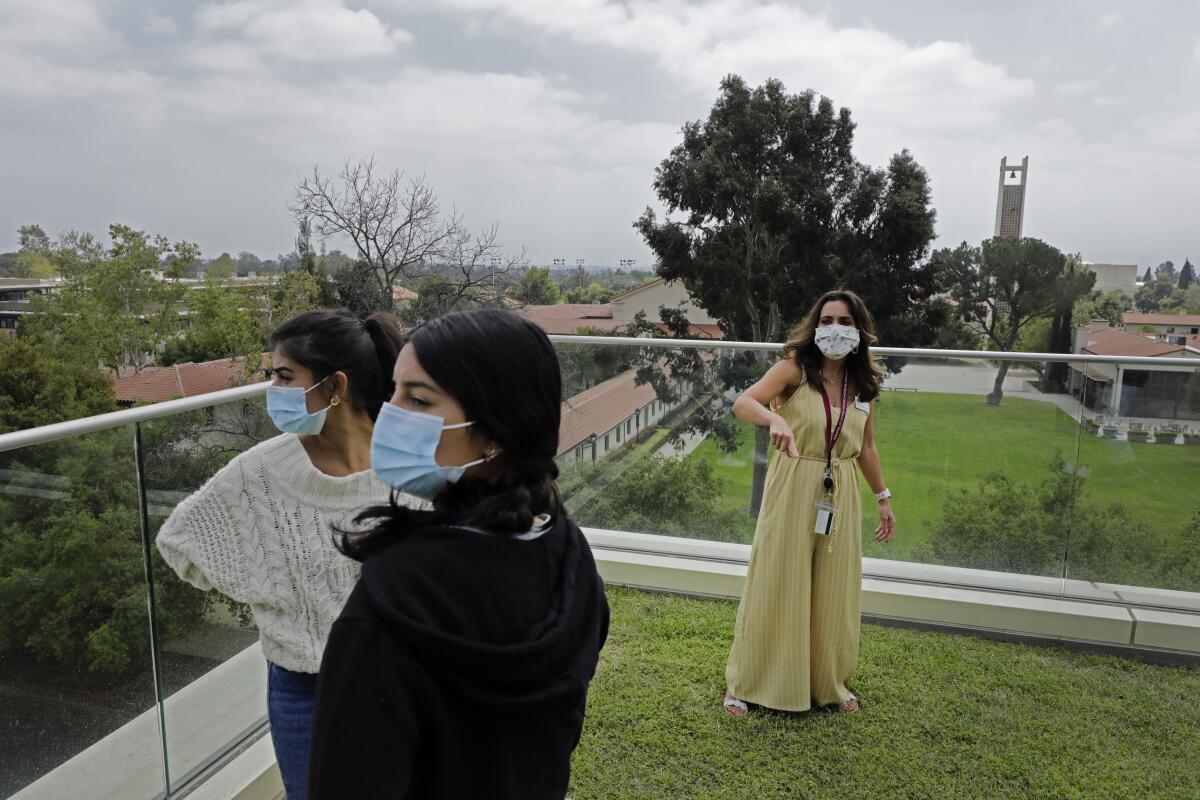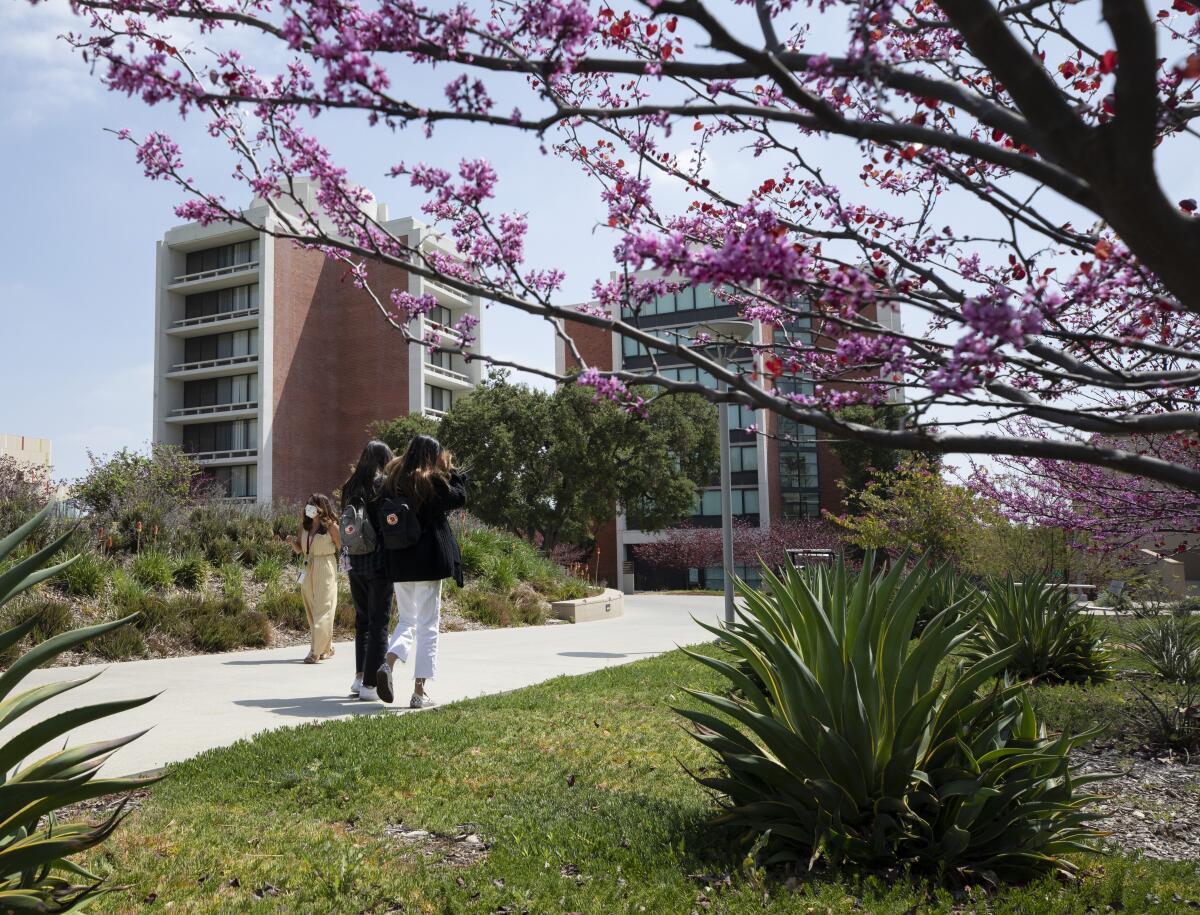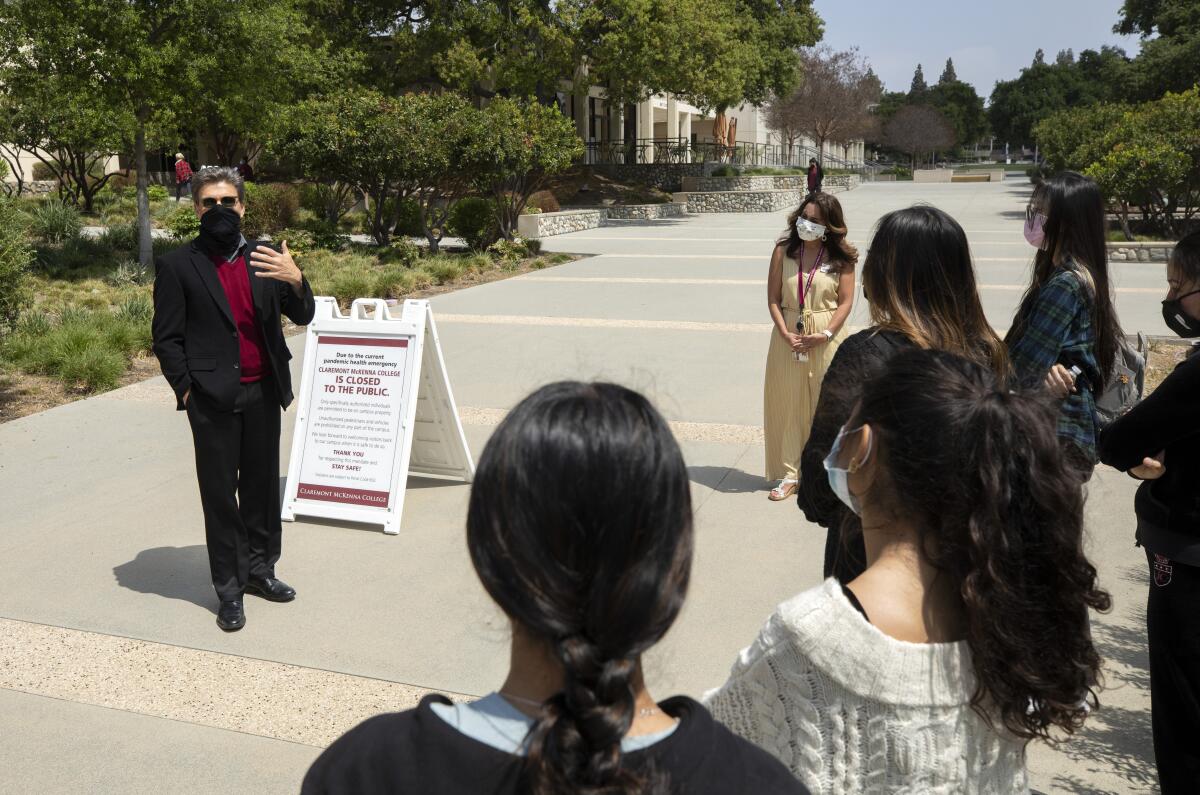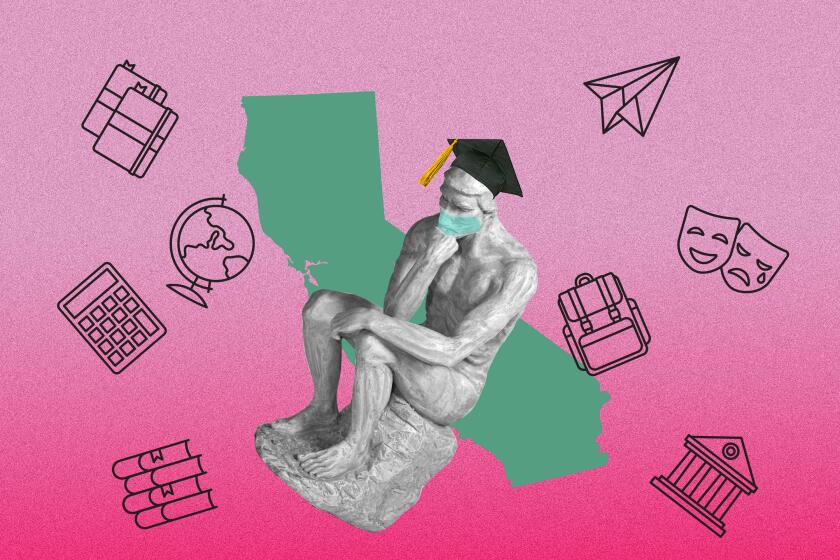Now the tables are turned and students get to accept or reject colleges such as UCLA and USC

- Share via
For a few tense months, between the time she submitted her college applications and received the momentous decisions, Rhea Mistry waited and wondered. Was her high school record strong enough for her choice colleges to accept her among thousands of other students in one of the most competitive admissions seasons ever?
“It’s horribly nerve-racking,” the Riverside Polytechnic High School student said. “You think: Did you do enough? Did you not do enough? You’re putting yourself out there to basically be judged as to whether you made the cut or not.”
She didn’t make it into Columbia University and was wait-listed at Barnard College. But she was admitted to UC Berkeley, UCLA, UC Riverside, USC, the University of San Diego, New York University, Chapman University and three of the Claremont Colleges: Claremont McKenna, Pitzer and Scripps.
Rhea has been chosen. Now it’s her time to choose.

April marks the month when the tables turn in the college admissions season — a time when campuses hope that their dream students will accept them by the May 1 decision deadline.
Just as applicants pitched their high grades, rigorous course loads and extracurricular achievements and poured out heartfelt essays, colleges are now in sales mode. It’s their worrisome time to showcase the strength of their academic programs, diverse student clubs, campus facilities, alumni networks and financial aid to seal the deal with their carefully selected applicants.
“I think of it almost as a pendulum swinging,” said Gary Clark, UCLA’s director of undergraduate admission. “When students apply to colleges and universities, they spend that time between when they apply and when they hear their decisions kind of stressing and wondering: Who’s going to choose me? Now I have to sit back and wait to see who’s going to choose us.”
UCLA is the most popular university in the nation, drawing more than 140,000 applications for about 6,300 freshman seats for fall 2021. Yet about 60% of students decline UCLA admission offers. Last year, for instance, the Westwood campus admitted 15,602 applicants in order to hit its enrollment target of about 6,400.
Among the University of California’s nine undergraduate campuses, Berkeley has the highest proportion of students accepting offers — known as yield rate — at about 45%. For most of the other campuses, only about two of every 10 students admitted accept the offer. USC this year admitted 8,800 prospective freshmen to hit its enrollment target of about 3,100.
“We don’t take anything for granted,” Clark said. “Students admitted to UCLA are admitted to probably a number of phenomenal colleges and universities, and we think it’s important for us to really go that extra mile to help convince students and families why they should choose us.”
Campus tours, Clark said, are one key lure, but the pandemic shut down in-person visits last spring and now. As new COVID-19 cases decline and state restrictions on gatherings ease, Claremont McKenna College and the University of La Verne are two of the few campuses that have brought back limited in-person tours.

On a recent spring day, Jennifer Sandoval-Dancs, Claremont McKenna’s associate vice president for admission and financial aid, showed off the campus to Rhea and her mother, along with two other families from San Diego and Washington, D.C.
In one tour highlight, Rhea took in the panoramic view of the campus and surrounding Pomona and Scripps colleges. On cue, Sandoval-Dancs amplified her sales pitch: Claremont McKenna not only offers close relationships among students and faculty but also close connections with the other four undergraduate campuses in the Claremont Colleges consortium.
We covered 11 campuses and 1,100 miles, from Camarillo to Davis. What did we learn?
Students checked out a classroom and dorm, the expansive athletic facility and the iconic “Cube,” a students-only space with glass walls set amid a shimmering pool of water. They strolled by “Green Beach,” a grassy open space that Sandoval-Dancs told them was always filled with students picnicking and playing soccer and Frisbee.
When Sandoval-Dancs told the group about a campus kitchen available to students, Rhea excitedly poked her mother. She had liked the classroom, noting that its intimate setup supported the college’s pitch that students get plenty of face time with their professors. But the idea that she could cook her vegetable stir-fries and other meals as she does at home was a huge attraction.
“That was one of the best things they could have told me,” Rhea said. “The kitchen and gym might be the selling point.”
For Emily Ma, a Long Island student passionate about science and dance, the Claremont McKenna tour put her back on the fence. She was expecting to commit to USC, drawn by the academics and big-time campus feel, including Trojan sports. But she fell in love with the smaller Claremont campus. She was impressed by the Athenaeum, a lecture and dining space that fosters free-wheeling discussions with high-profile speakers — and attracts students with chocolate-covered strawberries and Rice Krispies treats.
“Initially I was leaning toward USC, but now I’m stuck in the middle,” Emily said. “But it’s a good problem to have.”
That good problem for Emily, however, could be a bad one for USC. The university usually brings in more than 100,000 visitors for campus tours and myriad events for both admitted students and prospective ones, said Kirk Brennan, director of admission. Visitors take selfies in front of Tommy Trojan, stroll through the tree-lined quad, watch the marching band, meet faculty and students, visit dorms.
The tours make a difference: Students who visit campus are more likely to commit to USC than those who don’t, Brennan said.
“We know that when students come to our beautiful campus and feel that spirit and excitement, they’re more likely to be interested in and enroll,” he said.
He added that in-person visits also give families firsthand looks at the “downtown renaissance,” lively cultural enclaves such as Koreatown and the array of ethnic eateries suitable for student budgets. In one recent conversation with a top candidate from Washington, D.C., Brennan said, he talked up L.A. tacos more than the academic opportunities.
USC, UCLA and other campuses have tried to replicate that experience with online tours and virtual events. The UCLA portal for admitted students, for instance, features a welcome video showcasing the campus’ stately brick buildings, sports events and testimonies about Bruin life from diverse students in labs, classrooms and theaters — with some strolling in shorts under sunny skies.
Online events feature a range of interests including career preparation, undergraduate research and study-abroad programs, student experiences in chemistry and biochemistry, international student support, housing, diversity and health and wellness.
Diya Kapur was a Sunnyvale high school senior last year when she had to commit to a college based on virtual tours — which she supplemented with extensive conversations with students at UCLA, UC Berkeley and Georgia Tech in Atlanta. Each campus offered a strong academic program in her field of chemical engineering, so she was looking at other factors — location being key.
She wants to stay and work in California after graduation, so building a network here made more sense, she said. UCLA won. It’s far enough from her Bay Area home to give her some independence, she said, and she liked the welcoming vibe and the rave reviews about campus food.
“I’m a major foodie, and knowing UCLA is No. 1 in the nation — it doesn’t get any better than that,” Kapur said.
Such comparative shopping by students can be nerve-racking for college admission officers, since their predictions of how many will accept their offers carry potentially major financial ramifications. At USC, Brennan said, underpredicting the yield rate this year even by 2% could leave the campus short 200 students, “and that’s a full dormitory.”
“Everybody’s worried about enrollments — everybody,” Brennan said. “The primary fear is that not enough people will come. I wish that students appreciated how worried we were that they’re going to choose the competition. They sometimes don’t know their value or power in that relationship, and I think if they saw that they would feel more confident.”
Rhea is feeling that headiness right now. She was deluged with admission offers by campuses impressed by her 4.6 grade-point average, high class ranking, tough course load and impressive extracurricular activities — starting a nonprofit, for instance, and serving as a Riverside Unified School District student board member.
Yield — the percentage of students accepted to a college who ultimately decide to go there — is a crucial factor in higher education finance.
After much deliberation, she decided to commit to Pitzer College. Her tour of Claremont McKenna last week deepened her interest in a small college rather than a mega-campus like UC Berkeley, another top contender. Pitzer won out over Claremont McKenna because of its long and robust tradition of social justice and innovative educational programming, she said.
How does she feel about making that final selection among so many colleges vying for her?
“It’s a nice sense of empowerment to finally have something over them,” she said with a laugh.
More to Read
Sign up for Essential California
The most important California stories and recommendations in your inbox every morning.
You may occasionally receive promotional content from the Los Angeles Times.












